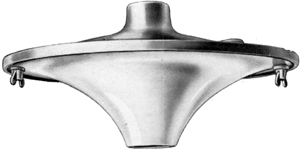|
BLEECO Open Type Conical Lantern 673
Genre: Open Type Conical Lantern
The open type conical lantern was on the first types of specialised street lighting lanterns
developed with early examples appearing in the 1900s or even possibly earlier. The design of
the distinctive conical reflector was designed to create a symmetric distribution in plan
with flux reflected at high angles to increase the illumination at distances from the lantern
and hence increase the space-height ratio required.
Whilst the theory was sound, many manufacturers elected to use white stove-enamelled steel-spun
over-reflectors. Unless extremely highly polished, these reflectors exhibited little specular
reflection as required by their design, and instead acted as diffusers. The result was a reutilisation
of some of the flux emitted in the upper hemisphere by the lamp but not at the required
high angles to achieve uniform illumination.
Therefore the lantern type was quickly discredited by many theorists and lighting designers
but to little avail. Local authorities looking for a cheap lighting solution installed this
lantern type in huge numbers, even after more scientifically proved lanterns with suitably
placed reflectors and refractors began to appear. The symmetric distribution was
also particularly suited for residential areas where a wide symmetric illumination was
particularly preferred.
It was kept on manufacturer's catalogues up until the 1950s when finally the specifications
caught up and required the lamps to be enclosed. But the lanterns themselves proved to be
remarkably durable – despite the rust problems of the thin spun steel reflectors – and many
were still in service during the 1980s and 1990s.

Name: BLEECO Open Type Conical Lantern 673
Date: Circa 1920s - 1950s
Dimensions: Width: 15½, Height: 7½
Light Distibution: Uniform Distribution
Lamp: 100-200W GLS
History
 The BLEECO Open Type Conical was the simplest lantern in the manufacturer's
range. Oddly it wasn’t present in the lone surviving 1934 catalogue
but was listed in leaflets dating from 1940.
The BLEECO Open Type Conical was the simplest lantern in the manufacturer's
range. Oddly it wasn’t present in the lone surviving 1934 catalogue
but was listed in leaflets dating from 1940.
It was made in three sizes with the largest taking a 200W GLS lamp.
Given its symmetrical light distribution, it was only really suitable for the lighting of
side streets, residential roads or large areas.
Identification
Early BLEECO lanterns have no manufacturers name or model number. Identification
is only possible by matching the lantern against those in catalogues.
The BLEECO Open Type Conical can also be readily identified by the
use of three wing-nuts which hold the enamel conical reflector in place – other manufacturers
used screws with large washers.
Popularity
The BLEECO Open Type Conical lantern was extremely popular in the south
of England where it was used to light many residential roads. Its use further north was more
limited where BLEECO came up against competition from local established firms.
Optical System
The lantern used a conical shaped over-reflector to redirect flux emitted above the horizontal.
The intention was to focus the flux at a high-angle symmetrically around the lantern and therefore
increase the range of the minimum illumination striking the road or path surface. In reality the
enamel surface acted as a diffuser and the flux was redistributed at all angles – whilst this ensured
that the lantern’s reflector appeared bright at all viewing angles, it meant that claims of the
lantern's efficiency were over-stated.
The BLEECO Open Type Conical 673 In My Collection

|
|
facing profile
I purchased this bracket and lantern from Surrey Council in 1994. It originally stood on a cast-iron column at the intersection of Arundel Road and Manor Road, Cheam.
|
|

|
|
front profile
Most of the installation around the residential roads of Cheam used ESLA Bi-Multi
lanterns but a small number were fitted with BLEECO Open Type Conical lanterns.
They may have been casual replacements, but as most could be found near junctions, then it's possible that
the symmetric distribution of this lantern was preferred at junctions than the non-axial asymmetrical
distribution of the 2-way ESLA Bi-Multis.
(However, 3 and 4-way ESLA Bi-Multis were used for junction lighting
in other parts of the installation so this theory may not be correct).
|
|

|
|
trailing profile
The lantern (and bracket) was painted silver. This was the colour used by Surrey Council for
its cast iron columns, brackets and lanterns.
The bracket was the original large Lucy bracket used for this lantern. These were commonly used by
Surrey for their residential streets.
|
|

|
|
canopy
The canopy of the lantern was completely smooth with no identifying marks. The lantern was only
identified by the use of copper wing-nuts to hold the canopy in place (confirming it as a
BLEECO) and measuring its dimensions against those in the
BLEECO catalogue (confirming it as a 673 and not the smaller 671 and
672).
|
|

|
|
pedestrian view
There was no lamp adjusting mechanism inside the canopy and this early 100W GLS lamp appears to big
for the lantern. It's possible that this lantern was designed for the smaller envelope GLS lamps which
appeared in the 1950s.
|
|

|
|
vertical
This view shows how simple the optical system of this lantern was. The flux was
simply redistributed symmetrically around the lantern – there was little light
control at all.
|
BLEECO Open Type Conical 673 During Restoration
This shot shows the lantern and bracket during restoration. The bracket had been partially restored and painted
and the lantern was half finished with a restored reflector.
Some other lanterns and brackets from the Cheam installation can be seen in the background.

|



